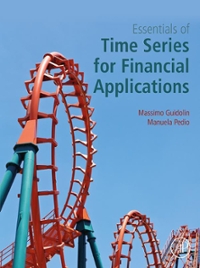Question
If Lauren drives to work, she has to use two toll roads - B(ertrand) and C(ournot) - named after the two firms which built these
If Lauren drives to work, she has to use two toll roads - B(ertrand) and C(ournot) - named after the two firms which built these two toll ways. Let TB be the toll charged by firm B for using Bertrand. Similarly, let TC be the toll charged by firm C for using Cournot. Lauren is willing to pay at most $12 (in tolls) per trip. Her demand for trips per week is given by Q = 12 TB TC Suppose the two firms, B and C, have no other costs. Each firm i(= B,C) chooses Ti to maximize its own profit i = TiQ.
(i) Find TB that maximizes firm B's profit, B, for a given TC. Similarly, find TC that maximizes firm C's profit for a given TB.
(ii) Suppose both firms set toll simultaneously. Let (T B , T C ) denote the Nash equilibrium prices. Find (T B , T C ) and profits of firms B and C in Nash equilibrium.
(iii) Suppose firm B chooses TB first and firm C chooses TC afterwards. What toll will firm B choose?
(iv) Election is in the corner. Opposition leader, Chandra, is proposing a price cap of $3 on tolls. That is, TA 3, TB $3. How will it affect your answer to part (ii)? Would firms be hurt with the price cap? [Treat profits in part (ii) as benchmark for comparison]
Remember Little Italy from PS 2? It has 100 consumers all of whom buy either one pizza or nothing. Each consumer has a reservation price of $15. That is, each consumer is willing to pay at most $15 for a pizza. There are two pizza stores - A and B - located next to each other. It costs $7 to make a pizza. Let pa and pb denote the price charged by stores A and B respectively. For simplicity, assume pi {$12, $15} for both i = A, B. Hereafter we ignore the dollar sign. Thus, prices can take just one of the two values - 12 or 15. If pi < pj , all consumers buy pizza from store i. If pi = pj = p then 50 consumers buy from store A while 50 buy from store B.
(i) Write down the payoff matrix. State the unique Nash equilibrium of the one-shot game.
(ii) Suppose the game is repeated twice. Is there a subgame perfect equilibrium where pa = pb = 15 in the first period? Assume that after first period, one-period profits are realised and each store knows whether or not the other store has charged 15 or 12.
(iii) Suppose the game is infinitely repeated. Consider the following trigger strategy by player i: Play pi = 15 in the first stage. In the t-th stage, if the outcome of all t 1 preceding stages has been (15,15) then play pi = 15; otherwise, play pi = 12. Assume a common discount factor of for both stores A and B. Can the two stores sustain pa = pb = 15 each period if = 2/3 ? What about = 1/3 ?
(iv) Now add pi = 9 to the set of possible prices. That is, suppose
Step by Step Solution
There are 3 Steps involved in it
Step: 1

Get Instant Access to Expert-Tailored Solutions
See step-by-step solutions with expert insights and AI powered tools for academic success
Step: 2

Step: 3

Ace Your Homework with AI
Get the answers you need in no time with our AI-driven, step-by-step assistance
Get Started


